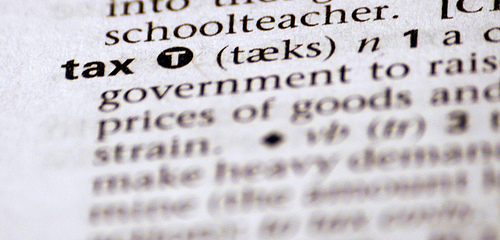In an effort to increase revenue and spur the local economy, San Francisco’s Office of the Controller is proposing two revised business tax plans that may end up on the November ballot.
The current system is a tax on employee payroll. It would be replaced by a tax on commercial real estate combined with either a less extractive payroll tax or a tax on all income. Ted Egan, the chief economist for the city and county of San Francisco, described the two proposals Tuesday at an event sponsored by the San Francisco Planning and Urban Research Association.
“Some businesses may pay more in rent and tax than they would in tax by themselves, but certainly [currently taxed employers’] taxes should go down,” Egan said.
Any new business taxes would have to be approved by more than 50 percent of San Francisco voters in November. Whether one or both of his proposals ends up on the ballot will be a political matter that is out of his hands, Egan said. Only the Board of Supervisors, the mayor or a citizen petition can put legislation on the ballot.
Egan said the current system — a 1.5 percent payroll tax that applies to only 6,000 of the city’s 80,000 businesses — is not an equitable system. Nor is it a stable one: Payroll is subject to great fluctuation, meaning the city’s tax base is highly volatile, Egan said.
Supervisor David Chiu has discussed these problems with Mayor Gavin Newsom and members of the chamber of commerce over the past year and eventually tasked the Office of the Controller with finding a better system, said Rob Black, vice president of Public Policy at the Chamber of Commerce.
“Typically, you tax things you don’t like,” Black said. “We in San Francisco actually tax jobs, which we do like and we want to create more of.”
Both of the proposals encourage new job creation by decreasing the payroll tax for major employers, Egan said.
The first proposal, a reduced payroll tax system, would apply to all businesses with employees. It would allow all businesses, regardless of size, to deduct the first $250,000 in payroll. For any additional payroll, businesses would pay a tax of 1.2 percent on the payroll of employees earning less than $85,000 annually and a tax of 1.5 percent for employees earning $85,000 or more. The average employee in San Francisco earns $85,000 a year, Egan said.
By allowing all businesses the $250,000 tax break, the cost of hiring for employers subject to the current business tax will decrease, encouraging them to increase hiring, Egan said.
Egan estimates that this proposal will create an average of 690 jobs per year for the next 20 years and help San Francisco’s economy grow by $108 million in that same period.
Egan’s second proposal would eliminate the payroll tax. Instead, the city would tax all businesses’ gross receipts, or their total income, by different amounts according to each sector’s anticipated costs of doing business. For example, although a grocery store and a law firm may have equal incomes, grocery stores would be taxed at a lower rate because of they have relatively higher business expenses.
By completely eliminating the payroll tax, this gross receipts tax system would create an average of 4,520 jobs per year for the next 20 years and help San Francisco’s economy grow by $613 million in that same period, Egan said.
The gross receipts proposal would bring more jobs and economic growth because payroll would grow faster than gross receipts, Egan explained.
Employers “are going to be paying less under the gross receipts tax than they would have under the payroll, so effectively, that’s a tax cut and that stimulates the economy an additional amount,” he said.
To make up for the revenue lost by decreasing the payroll tax, both proposals include a commercial real estate tax of 1.395 percent. The payroll proposal would bring the city $18 million more in annual revenue than the current system, while the gross receipts proposal would increase city revenue by $21 million, Egan said. The current payroll tax revenue is around $350 million.
The cost of the real estate tax would likely be passed on from building owners to tenants, he said. (Most commercial landlords write clauses into their leases that pass new taxes through to existing tenants.) This way, even banking and the financial sector, which are exempted from payroll taxes under state law, would contribute to the tax base because they occupy significant office space in San Francisco. With rents increasing across the board, nonprofits and government agencies renting from commercial landlords also would indirectly feed the revenue stream.
“Anyone who rents commercial real estate will contribute,” Egan said.
Some members of the business community, however, are concerned that this additional tax would hurt the economy by increasing rents.
“One thing to recognize is that any tax, whether large or small, is generally passed on to the tenants,” said John Bozeman, the legislative assistant for Building Owners and Managers Association San Francisco. “It comes down to the tenant in the end and the consumer they’re trying to service. So it does disservice to everyone.”
One audience member at Egan’s talk on Tuesday speculated that by encouraging job creation while taxing real estate, the city might influence businesses to squeeze more employees into smaller spaces.
Black said that San Francisco government is trying to create an image as a business-friendly city, and that these new proposals are part of that effort. Most recently, the Board of Supervisors passed an ordinance Tuesday to extend an existing payroll tax exemption to benefit more biotechnology businesses.
“Where the city is trying to do things to revise the tax code to be business-friendly, that perception permeates and convinces businesses to move here,” Black said. “It allows us to say ‘You’re welcome. We want you. And we’re working with you even though it’s not a lot of money.’”
Egan’s two proposals will be available online Friday at www.sfcontroller.org.









